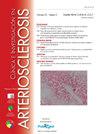Hábitos nutricionales en los pacientes con enfermedad arterial periférica: adherencia a la dieta mediterránea
IF 1.9
Q3 PERIPHERAL VASCULAR DISEASE
引用次数: 0
Abstract
Introduction
Adherence to the Mediterranean diet (Dietmed) exerts protective effects on cardiovascular disease (CVD). In the Lower Extremity Peripheral Arterial Disease (PAD) there are fewer studies that analyze these data.
Objective
To determine adherence to Dietmed and dietary habits in patients with PAD, according to a history of CVD (coronary and/or cerebral ischaemic pathology) and according to the ankle-brachial index (ABI ≥ or <0,5).
Material and methods
Cross-sectional analytical study carried out in a tertiary hospital. The sample was collected consecutively. Sociodemographic and clinical history, ankle-brachial index (ABI) and a 14-point Dietmed adherence dietary questionnaire were included. The analysis of categorical variables was carried out using the Pearson's Chi-Square test, the T-Student's statistic test for independent samples was used for parametric variables and the U. Mann-Whitney test for non-parametric variables.
Results
Of the 97 patients, 87,6% had low adherence to Dietmed, with no differences according to the severity of PAD. However, when we analysed the data according to whether or not they had a history of CVD, we observed a high adherence to some items included in Dietmed, specifically, in the CVD group, the consumption of lean meat (95,5% vs 64%; P=.004). In addition, we observed a significant difference in the consumption in the group without a history of CVD (32% vs 9,1%; P=.033).
Conclusion
In our population, patients with PAD, regardless of the stage of the disease and whether they had associated coronary or cerebral ischaemic pathology, had low adherence to Dietmed. Therefore, it is important to implement nutritional education programmes in patients with PAD in all stages, as well as in those patients who have already suffered a vascular event, so that they maintain adherence to healthy dietary habits in the long term.
外周动脉疾病患者的营养习惯:坚持地中海饮食。
导言:坚持地中海饮食(Dietmed)对心血管疾病(CVD)具有保护作用。在下肢外周动脉疾病(PAD)方面,对这些数据进行分析的研究较少:根据心血管疾病病史(冠心病和/或脑缺血病)和踝肱指数(ABI ≥ 或 材料和方法:在一家三级医院进行的横断面分析研究。样本连续采集。研究纳入了社会人口学和临床病史、踝肱指数(ABI)和 14 点 Dietmed 饮食依从性问卷。对分类变量的分析采用皮尔逊秩方检验,对参数变量采用独立样本 T-Student 统计检验,对非参数变量采用 U. Mann-Whitney 检验:在 97 名患者中,87.6% 的患者对饮食治疗的依从性较低,与 PAD 的严重程度无关。然而,当我们根据患者是否有心血管疾病病史对数据进行分析时,我们发现他们对饮食医学中某些项目的依从性较高,特别是在心血管疾病组中,瘦肉的摄入量较高(95.5% 对 64%;P=.004)。此外,我们还观察到无心血管疾病史组的食用量有显著差异(32% vs 9.1%;P=.033):结论:在我们的研究人群中,PAD 患者无论处于哪个阶段,也无论是否伴有冠状动脉或脑缺血病变,对饮食治疗的依从性都很低。因此,对各阶段的 PAD 患者以及已发生血管事件的患者实施营养教育计划非常重要,这样他们才能长期坚持健康的饮食习惯。
本文章由计算机程序翻译,如有差异,请以英文原文为准。
求助全文
约1分钟内获得全文
求助全文
来源期刊

Clinica e Investigacion en Arteriosclerosis
PERIPHERAL VASCULAR DISEASE-
CiteScore
3.20
自引率
6.20%
发文量
44
审稿时长
40 days
期刊介绍:
La publicación idónea para acceder tanto a los últimos originales de investigación como a formación médica continuada sobre la arteriosclerosis y su etiología, epidemiología, fisiopatología, diagnóstico y tratamiento. Además, es la publicación oficial de la Sociedad Española de Arteriosclerosis.
 求助内容:
求助内容: 应助结果提醒方式:
应助结果提醒方式:


